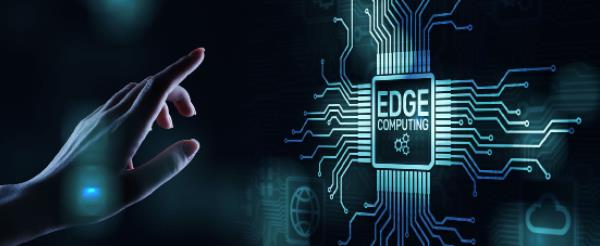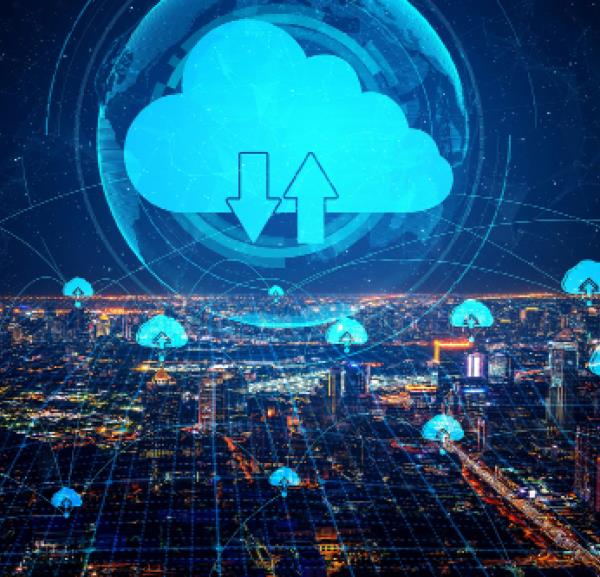11 November 2021

What’s the difference? Will one replace the other? Can they co-exist? We ask the experts
Is edge computing just a fancy new name for a type of cloud computing, or is it totally different?

Peter Ruffley, CEO, Zizo: The fundamental difference between edge and cloud computing is that edge computing means dealing with the data where it is produced or collected, whereas cloud computing means moving all of the data onto the cloud before you do anything with it. There are many different types of computing devices that can be utilised in a variety of scenarios in a highly cost-effective way. This means that the collection and processing of data can take place in many circumstances which previously would have been considered unfeasible. For example, small devices which use less than 40 W of power can be deployed in remote environments, powered by wind or solar power. They have sufficient capability to store and process huge amounts of data on their own.

Mark Richman, principal product manager, iManage:
Rather than thinking of edge computing as something “totally different”, it’s more useful to view edge computing as part of the push-and-pull that has shifted computing power from the client to the server and back again over the course of the modern computing era. First, computing power moved from the mainframe to the PC, the second shift was to client-server computing, then it moved from the PC to the cloud. Now the pendulum is starting to swing back in the other direction, towards the edge. It’s important to keep in mind, however, that most edge devices can’t accomplish much on their own unless they have access to the cloud, so in some ways, edge computing is just a fancy new name for a type of cloud computing. Bottom line: this is just a different version of the same computing power story that’s been playing out for the past 70 or so years.

Iain Davidson, senior product marketing manager, Arkessa: Edge computing is different. It reflects where processing is done in a network or system context. For example, with edge computing data is captured, processed and actioned on the sensor device, or perhaps in a gateway device or server which is located on-site. In contrast, cloud computing involves moving data over internet links to data centres for processing. Edge Computing is capable of more real-time decision-making but requires more compute capacity and power in the sensor. Whether Edge or Cloud is best, as well as the relationship between Edge and Cloud, will depend on the application requirements. Distributed Multi-access Edge Compute (Distributed MEC or DMEC) is a hybrid approach which we will touch on later. Wireless Logic partners with Vodafone and AWS to bring DMEC capabilities to market.

Russ Kennedy, chief product officer, Nasuni: Edge computing is totally different. Cloud computing is more of a centralisation of computing tasks, whereas edge computing is purely distributed and designed to capture the massive amounts of data being generated at the edge in real time. We’re going through a period of massive technological change. Think about the volume of data being generated by autonomous vehicles. The sensors are capturing data in real time, and the vehicle needs to make decisions in real time, right there at the edge. Edge computing is highly transactional. You have huge volumes of data coming in at highly accelerated rates, and you need to be able to capture, analyse, and make decisions right there on the spot. We see something similar with enterprise file storage, as large global organizations need storage resources to be accessible in geographically distributed locations. An office in London shouldn’t have to reach over to Los Angeles to access data – these files should be available at the edge, in London. At Nasuni we embrace that edge architecture, and the needs of the edge, while also recognising that there is a need to centralize this data for protection, security, collaboration, and analytics. The idea is to make data available at the edge for people working in distributed locations but also be able to centralize this data back to the cloud.

Tim Mercer, CEO, Vapour: While edge computing complements the cloud and can form a key part of an organisation’s tech infrastructure, it is totally different. As the name would suggest, it sits on the edge, as opposed to in the private, public or even hybrid cloud domain. Typically used to run applications with real-time, sensitive data, it provides access to that data, locally, so that you can do what you need to with it, and when you’re finished, it is sent to the cloud to be managed and supported. It is (or should be) used in instances when sending that real-time data to the cloud would be too slow, too expensive, or cause latency issues.
Do edge and cloud computing suit certain industries better than others?
Peter Ruffley, CEO, Zizo: The applicability of the two solutions isn’t decided by industry or sector. Instead, it’s to do with the amount and value of the data being processed, as well as the availability of connectivity. In circumstances where there is good connectivity and the data has a known value, such as the financial sector, then cloud-based solutions will be very effective. Some industrial scenarios may prevent the implementation of Wi-Fi for security reasons, so an edge solution would be the only possible solution. Other industrial sectors, for example, the maritime industry, would deploy an edge solution because there is no consistent connectivity on the majority of merchant shipping.
Mark Richman, principal product manager, iManage:
There are certain industries and applications that initially jump to mind when thinking about edge computing, IoT being a prime example. There’s a lot of innovative work in particular being done on the “industrial IoT” side of things, with small computing devices that can be placed on trains, tractors, earthmoving equipment, and other heavy machinery. These devices can gather real-time metrics on location, performance, and environmental conditions, and then send that data en masse to the cloud where it can be further processed. This is far from the only setting taking advantage of cloud and edge, however. There’s plenty of edge and cloud computing taking place in knowledge work industries, where there are a combination of applications that professionals use every day that either run on a user’s device (edge) or run in a purely web version (cloud). Again, it’s really the combination of edge computing and cloud computing that’s key, and there can be different kinds of expressions of that combination across different industries.
Iain Davidson, senior product marketing manager, Arkessa: Yes, although it is perhaps less about industries and more about application requirements. Applications that require highly responsive, real-time control such as manufacturing, robots, AV, next-gen micro-mobility, remote crane operation, or even remote surgery all have a fundamental safety-critical dimension that translates into real-time processing, ultra-low latency, and ultra-reliable communications. In these circumstances, edge computing combined perhaps with private LTE or 5G networks is the best fit. In contrast, large enterprises managing campuses, energy networks, road networks, or cities using large fleets of devices will almost certainly adopt a cloud-based approach. The common theme in these cases is capturing, merging, and processing sensor inputs from a wide array of sources to determine near-term actions, to build a predictive maintenance model (machine learning), or to investigate any failures. Having data in a cloud environment for both near real-time aggregation, processing, and offline processing makes sense. For example, consider a town with air quality, noise, traffic, weather, lighting, parking, EV charge points, micro-mobility fleets, and security monitoring systems. CCTV aside, these sensors will typically produce small amounts of regular data. The economics of large fleets dictate that managing the cost and maintenance of remote devices will be important. As such they will be connected and managed via 4G or 5G technology, likely a mix of lower power technologies (like LTE-M or NB-IoT), or higher performance 4G/5G in some cases like law enforcement (body cameras) or HD CCTV (e.g. image recognition, detection of littering and so on). In reality, a hybrid approach (edge and cloud) is most likely required depending on the application requirements.
Russ Kennedy, chief product officer, Nasuni: Any industry in which data is being generated from sensors and machines at the edge is suited for this type of architecture. I mentioned autonomous vehicles, but Healthcare is another key example, as you have medical equipment, sensors, and various other devices providing information that needs to be processed quickly to inform decision making. We see the need for edge computing with some of our large manufacturing clients, too. If they want to optimize processes, they need to be able to analyse data in real time.

Tim Mercer, CEO, Vapour: Edge computing is particularly relevant in scenarios that require rapid access to real-time data. IoT strategies, driverless cars and health wearables are all great examples where the data better resides on a device on the edge. Many people wouldn’t consider their mobile phone as an edge device, for example. But my phone gives me real-time local access to the data produced by my Garmin watch (a wearable), and that data is then stored in Garmin, when I no longer need it. The new BMW iX comes with a 5G SIM which enables the sharing of live traffic information with other 5G cars nearby, to inform drivers’ chosen routes. In fact, 5G has been a major driver in edge computing advancements, as it presents a speed of connectivity that just wasn’t possible before.
Why is the edge often touted as the cloud’s successor?
Peter Ruffley, CEO, Zizo: I don’t think it’s right to say that edge is a successor to the cloud – instead, it’s more of a realisation that cloud solutions aren’t always able to be provided in every scenario. We talk constantly about the connected society, but in many places and situations, there may not be a cost-effective and reliable connectivity solution in place. That is a prerequisite of any potential cloud-based solution being implemented. Alternatively, edge-based solutions offer a way forward when no cloud-based solution can be provided. In the days of big data and then IoT, there was a rush to collect all data, without much thought about the cost of doing that, storing it and what its potential value might be. This resulted in the creation of huge amounts of data, stored in such a way that made it difficult to extract anything from it, least of all business value. Edge computing is developing as a more thoughtful, structured and potentially lower-risk approach to those data-rich projects.
Mark Richman, principal product manager, iManage: I don’t think edge is the cloud’s successor, because there’s always going to be massively more computing power available in the cloud than is ever going to be available on any single edge device. Even though computing power has increased exponentially, the massive parallel processing power of a cloud is always better. To me, the edge being touted as the cloud’s successor is highly reminiscent of the idea that PCs were going to kill the mainframe back in the 80s. PCs didn’t kill the mainframe; the mainframe just evolved and became the cloud. So, edge computing is not going to be the cloud successor: the two are going to continue to work together, just in new and different ways.
Iain Davidson, senior product marketing manager, Arkessa: With advances in cellular networks and microprocessor technology, Edge computing is now more economically and technically viable so it is undeniably on the rise, but it won’t replace cloud computing, it will complement it. Cellular networks now provide options for low power, high-density sensor deployments as well as low-latency, high-speed connectivity. The computing density of microprocessors continues to increase and combines general CPU performance with image processing and AI engines. Edge is on the rise.
Russ Kennedy, chief product officer, Nasuni: I’m not sure it should be touted as the cloud’s successor. Both will continue to exist because they satisfy distinct needs. Edge computing is all about rapid capture and processing of information where it’s generated. Cloud is more about the centralization of resources and, in the case of cloud file storage, all the amazing things you can do once your data is centralised in a single, globally accessible namespace.
Tim Mercer, CEO, Vapour: I’ve read stat after stat about edge computing, with one claiming that almost 80% of decision makers will use it over the next 12 months. These figures aren’t surprising, because, in all honesty, I think edge computing has been around for some time – it’s just got a shiny new name badge. And I don’t think the debate is as simple as one or the other, as the technologies are complementary. It doesn’t matter if a customer is running 30 applications – if there’s even one that they’re heavily reliant on, is particularly complex or they require data from in real-time, we will talk to them about the ability to manage it locally, before sending the data to the cloud for storage. We’ve done this for some time. As should always be the case in the tech space, decisions should be made on a case-by-case basis.
Can the two co-exist peacefully?
Peter Ruffley, CEO, Zizo: Absolutely, the two complement each other very well. Businesses can benefit from having a collaborative situation where, for example, low value data was collated and analysed at the edge and then the results are sent up to the cloud-based solution for aggregation and overall analysis. This can provide cost-effective and robust computing solutions. It seems to me that there is a role for both of the solutions going forward. There is no doubt that having high-value complex AI and ML solutions available on the cloud is going to be very important in the future, but the reality is that to get the most from them, you only want to use them on data that has known value.
Mark Richman, principal product manager, iManage: Absolutely. Edge and cloud are two computing approaches that work together – they’re complementary. You might have one application that has a greater reliance on the edge and one that has a greater reliance on the cloud, but these two approaches will continue to work together, co-existing peacefully.
Iain Davidson, senior product marketing manager, Arkessa: Yes. They have to - and in fact, there are hybrid solutions available today which combine the two in a complementary fashion. Take DMEC for example; Wireless Logic partners with Vodafone and AWS to bring Distributed Multi-access Edge Compute (Distributed MEC or DMEC) capabilities to market. DMEC enables the cloud processing to be performed at the edge of the mobile core network which helps significantly reduce latencies associated with moving data between device and cloud.
Russ Kennedy, chief product officer, Nasuni: There is absolutely a place for both of them to exist and evolve. I see them as complementary not competitive solutions. From the cloud perspective, some or all of that data being generated and processed at the edge might need to be captured preserved for post-process analysis, legal analysis, compliance, or general data protection. Nasuni has embraced the idea that edge and cloud are complementary, and a result we’re able to provide our customers with the performance they need at the edge while simultaneously preserving, protecting, and securing that data in the cloud – and as a result making it available for analysis in a post-processing environment. The data might not exist without the edge resources, but none of these additional benefits would be available without the cloud.
Tim Mercer, CEO, Vapour: Yes. Linked to what I’ve already said, it doesn’t have to be ‘one or the other’ and decisions should be made according to factors such as cost, security, performance, scale and so on.
When it comes to the public versus private cloud debate, we’d never categorically say one or the other. It’s much the same in terms of edge versus cloud computing, but it needs a confident, customer-focused, technology agnostic specialist to truly advise on what’s right for the business, and not just push the solution that’s most familiar to them.
Does cloud or the edge have an advantage in 2021?
Peter Ruffley, CEO, Zizo: Right now, you could always design and deploy an edge-based solution, but you simply can’t say that about the cloud. There are also question marks over the costs of cloud and understanding what they may be as solutions scale up. There has been a tacit understanding because cloud solutions are now very widespread that somehow they have been commoditised, and therefore, the costs have come down. This may not be the case as solutions grow larger and more complex, as, in turn, the incremental costs of cloud storage can start to rise steeply. This can be a problem if you are holding large amounts of low-value data.
Mark Richman, principal product manager, iManage: I think I reject the premise of the question: to my mind, it’s not a matter of one having the advantage over the other. Ultimately, these two things work together, and you can lean more towards “edge” or more towards “cloud” depending on your application and what you’re trying to achieve. Most applications these days would really struggle to deliver a robust solution relying strictly on edge computing, because they fundamentally rely on the power of the cloud to aggregate all of the information that is generated at the edge. There certainly could be applications where you could have edge devices that potentially communicate entirely in a peer-to-peer fashion with no centralised cloud, but the applications for that are going to be very specific and somewhat limited. At the end of the day, the choice of cloud or edge really depends on the application. There’s value for each, and there’s value in combining them in different proportions, based on what you’re actually trying to achieve.

Iain Davidson, senior product marketing manager, Arkessa: Edge computing will have some advantage in the sense that it enables genuine transformation in IoT. That said, it will also drive new distributed edge (DMEC) and traditional cloud-based workloads. Edge compute devices will still share data with cloud-based systems after all and in many scenarios, a hybrid approach will be adopted.
Russ Kennedy, chief product officer, Nasuni: There is absolutely a place for both of them to exist and evolve. I see them as complementary not competitive solutions. From the cloud perspective, some or all of that data being generated and processed at the edge might need to be captured preserved for post-process analysis, legal analysis, compliance, or general data protection. Nasuni has embraced the idea that edge and cloud are complementary, and a result we’re able to provide our customers with the performance they need at the edge while simultaneously preserving, protecting, and securing that data in the cloud – and as a result making it available for analysis in a post-processing environment. The data might not exist without the edge resources, but none of these additional benefits would be available without the cloud.
Tim Mercer, CEO, Vapour: The application drives this, not the solution. So, it depends on the scenario. And customers – certainly those with savvy CTOs – are asking more probing questions to ensure they receive the right recommendations. They’re talking to vendors about how to better manage their applications, how these applications traverse networks, what they do inside businesses, how they can affect overall network performance, and so on. There’s also a larger appetite for making corporate networks more secure, agile and scalable, and for many businesses, cloud and edge will both have a role to play.
What are the key things an enterprise should consider when choosing a supplier?
Peter Ruffley, CEO, Zizo: Before businesses think about choosing a supplier, they should have constructed a strong business case. In the case of IoT, something that both edge and cloud solutions are available for, you should have clearly identified what level of value you expect to get from the solution. As well as considering what the potential value of the data that you are collecting might be, you have to seriously consider which pieces of the solution are in place and how much it will cost to put them in place if they are not.
For example, if you are looking at implementing a cloud-based solution, but it will involve the installation of factory-wide Wi-Fi, then it may represent too much risk, such as too much money being spent before the value of any return can be assessed. Edge-based solutions can represent a lower risk in determining potential business value.
Mark Richman, principal product manager, iManage: Really, it depends on what the end user is trying to achieve. That being said, as with anything, security is key, especially as more and more data is gathered at the edge. That means tens or hundreds of different places to secure rather than just one central location like the cloud. How is data actually being secured at the edge? Updateability is a big part of this larger security aspect – making sure that those edge devices have ways of being patched or updated as security improvements continue to evolve. Likewise, upgradeability is something for enterprises to carefully consider: what are the implications when newer and better capabilities come along for increased processing power at the edge? How are they going to be able to upgrade these edge devices as new capabilities evolve? What happens if an edge device breaks, and you need to replace it – how are you going to do that? There are a lot of factors that need to be considered, no matter what application you’re trying to implement.
Russ Kennedy, chief product officer, Nasuni: Enterprises should start by asking a few fundamental questions. What is your specific need? What are you looking to do at the edge? What types of data are you going to be processing and analysing? What outcomes are you looking for once this data is processed? Once you understand your needs, you can start to look at vendors. From a storage perspective, which is where we operate, and an analytics and processing perspective, there are going to be lots of choices, so I’d start with your needs and match vendor capabilities to that list.
-(002).png?lu=245)







